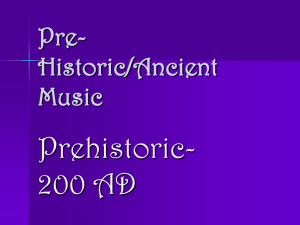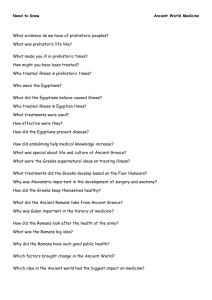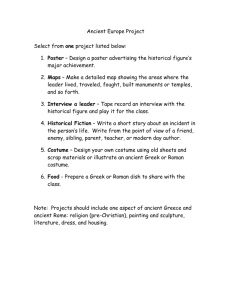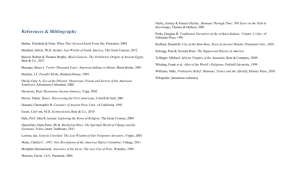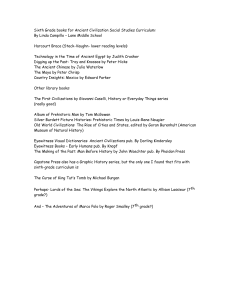Music History World Music - Ancient Music Lecture Notes Prehistoric
advertisement
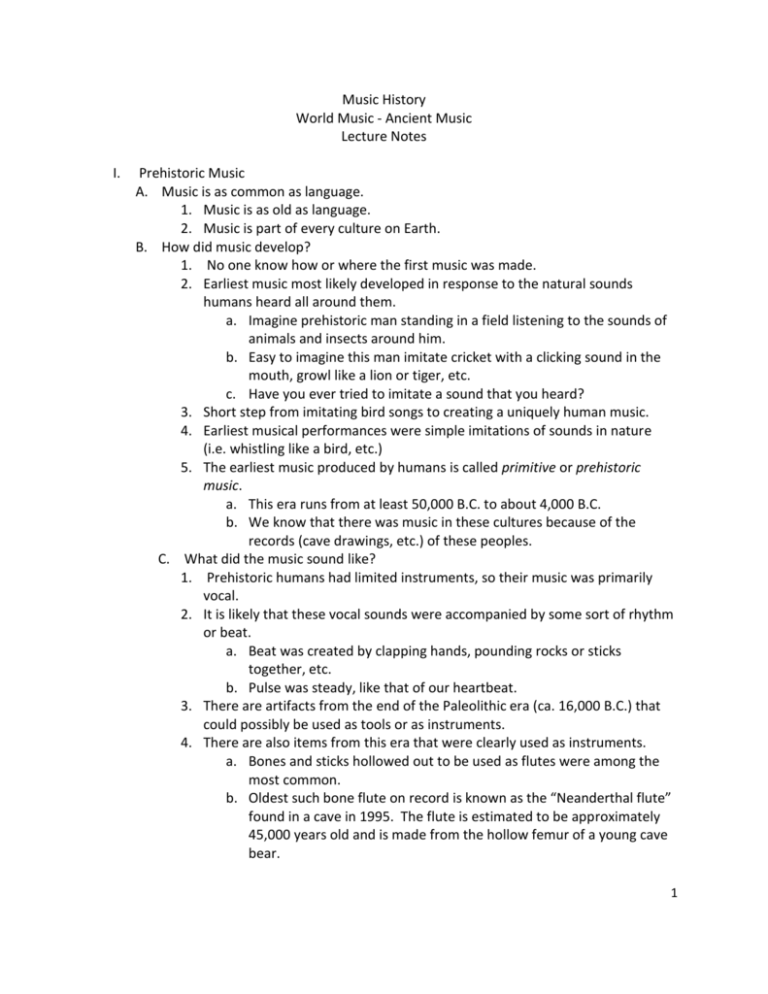
Music History World Music - Ancient Music Lecture Notes I. Prehistoric Music A. Music is as common as language. 1. Music is as old as language. 2. Music is part of every culture on Earth. B. How did music develop? 1. No one know how or where the first music was made. 2. Earliest music most likely developed in response to the natural sounds humans heard all around them. a. Imagine prehistoric man standing in a field listening to the sounds of animals and insects around him. b. Easy to imagine this man imitate cricket with a clicking sound in the mouth, growl like a lion or tiger, etc. c. Have you ever tried to imitate a sound that you heard? 3. Short step from imitating bird songs to creating a uniquely human music. 4. Earliest musical performances were simple imitations of sounds in nature (i.e. whistling like a bird, etc.) 5. The earliest music produced by humans is called primitive or prehistoric music. a. This era runs from at least 50,000 B.C. to about 4,000 B.C. b. We know that there was music in these cultures because of the records (cave drawings, etc.) of these peoples. C. What did the music sound like? 1. Prehistoric humans had limited instruments, so their music was primarily vocal. 2. It is likely that these vocal sounds were accompanied by some sort of rhythm or beat. a. Beat was created by clapping hands, pounding rocks or sticks together, etc. b. Pulse was steady, like that of our heartbeat. 3. There are artifacts from the end of the Paleolithic era (ca. 16,000 B.C.) that could possibly be used as tools or as instruments. 4. There are also items from this era that were clearly used as instruments. a. Bones and sticks hollowed out to be used as flutes were among the most common. b. Oldest such bone flute on record is known as the “Neanderthal flute” found in a cave in 1995. The flute is estimated to be approximately 45,000 years old and is made from the hollow femur of a young cave bear. 1 c. The flutes were very similar to their modern day counterparts. The had a single hole to blow into and the most sophisticated had holes punched into them to produce additional pitches. II. Music in the Ancient World A. What is the ancient world? 1. Early humans stayed on the African continent until about 50,000 years ago. 2. At that point, they began to migrate northward toward other countries. 3. These people were called prehistoric because they were yet to document their own history. Prehistory literally means a time before history was written down. 4. Now, humans began to develop a written language. So they began to write down their storied. 5. Music from the period from approximately 4,000 B.C. to just after the fall of the Roman Empire in 476 A.D. is known as ancient music. B. What was ancient music like? 1. Because the world was growing larger, music began to develop in different ways in different places. a. An ancient musician that discovered a set of pitches in Mesopotamia could not share that information with a musician in China. b. This made for a slow learning curve and slow growth in musical development. c. However, this allowed music to fully assimilate itself into each individual culture in a unique way that was not duplicated anywhere else. C. Cultures and Musics of the Ancient World 1. Egypt a. Advanced culture with technology (controlled irrigation from the Nile River), architecture (the pyramids), and art (writing system, literature and art). b. Regarded music as a gift from the gods c. No written example of Egyptian musical notation is known to exist. d. It is believed that the music was based on a simple scale and that male and female voices participated. e. Egyptians also used instruments in their music making. A. Included stringed harps and lutes from as early as 4,000 B.C. B. Percussion instruments were added to the music around 2,000 B.C. C. Tambourine, guitar and trumpet were used around 1,500 B.C. D. Harps, lutes and lyres were the first stringed instruments to be used. E. Again, this information comes from iconography and the Bible. 2 2. Mesopotmia a. Known as the cradle of civilization. b. Area of land located between the Tigris and Euphrates Rivers in modern day Iraq. c. Home to some of the most advanced ancient peoples. d. In this region, societies made music a central part of their religious rites and festivals. e. Beginning around 1800 B.C., Babylonians included psalms and hymns in their worship services. The musical style consisted of two different voices alternating in chant (antiphonal). f. Typical instruments from this area include flutes, drums, and harps. g. The earliest known written music was found in the ancient city of Ur. A. Music was in a tablet form. B. Created circa 2000 B.C. C. Sometimes referred to as “the oldest song” D. Tablet is actually set of instructions on how to perform music of this era. Gives information on tonality and instruments. 3. Greece a. Home of the first truly European music b. Period from approximately 500 B.C. to 300 B.C. c. Greeks were concerned with explaining the world (think of philosophy, Pythagoras’ theory, etc.) Looked for a set of patterns that naturally occurred in something and then sought the reason for that. d. This is how the Greek’s approached music – from a very mathematical perspective with religious overtones. e. Religious aspect: A. Ancient Greeks believed that music originated from Appollo B. Believed music reflected laws of harmony that rule universe. C. Music influenced human actions and thoughts. f. Mathematical aspect: A. Pythagoras (580 B.C. – 500 B.C.) was a mathematician that dabbled in music on the side. B. Discovered mathematical relationship between frequencies and intervals by using a single-string instrument to produce a variety of pitches. C. Pythagoras divided the string into smaller and smaller sections(similar to the way a fret board works on a guitar). D. Discovered ratios that led to the development of the modes that transformed into the scales that form the basis of western tonal music. 3 E. III. In 340 B.C., Aristotle (384 B.C. -322 B.C.) laid the foundations of music theory. F. In his treatise The Politics, he noted the affect that various melodies, modes and rhythms have on the listener. G. He argued that since this element had great power on developing character, it should be a viable part of educating the young. g. How did Greek music sound? A. It was primarily monophonic. B. There was vocal (songs) and instrumental music. C. Common instruments included flutes, lyres, and numerous percussion instruments. 4. Roman Empire a. Roman Empire encompassed range of territories from England to Spain to Turkey to Egypt to Greece. b. Musical ideas developed by the Greeks were preserved by the Romans. c. Roman music was heavily influenced by the many lands that it was comprised of. d. Musical theatre flourished. e. Professional musicians had their own organizations. Looking Ahead A. Roman culture continued to preserve the musical ideas of the Greeks until the fall of the Roman Empire in 476 B.C. B. Cultural center of the Western world then began to move north in to modern day Europe. 4


